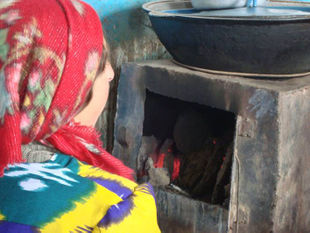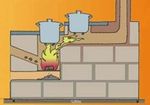Knowledge fuels change - Support energypedia!
For over 10 years, energypedia has been connecting energy experts around the world — helping them share knowledge, learn from each other, and accelerate the global energy transition.
Today, we ask for your support to keep this platform free and accessible to all.
Even a small contribution makes a big difference! If just 10–20% of our 60,000+ monthly visitors donated the equivalent of a cup of coffee — €5 — Energypedia would be fully funded for a whole year.
Is the knowledge you’ve gained through Energypedia this year worth €5 or more?
Your donation keeps the platform running, helps us create new knowledge products, and contributes directly to achieving SDG 7.
Thank you for your support, your donation, big or small, truly matters!
Dung-burning Cookstoves
Cooking Energy System | Basics | Policy Advice | Planning | Designing and Implementing ICS Supply | Designing and Implementing Woodfuel Supply | Climate Change | Extra
Introduction
Dung, the undigested waste of plant-feeding animals, is a widely used fuel source, especially for low-income households and in regions, where it is freely available and accessible without payment. Dung is either collected in stables with domesticated animals or from pastures with free-range domesticated or wild animal herds. It is mostly burnt in traditional stoves.
See also the energypedia article on Cooking with Dung.
Stoves for Cooking with Dung
Traditional Dung Stoves
Burning dung in most traditional stoves is not very convenient, because:
- Due to the low carbon content, dung fire is not very hot
- Due to insufficient air, low carbon content and a high moisture content, dung fires are often smoky
- Due to volatiles, dung fire can stink
- It can corrode the metal parts of a stove due to chlorides that can form dioxins under certain conditions
- It has a high ash content
These observations are mainly a result of the low fire temperature caused by the low carbon content and the high moisture content of the dung even after sun-drying. The evaporation of this water is reducing the temperature of the fire, leading to incomplete combustion. Dung contains many volatiles that can cause a stringent smell when heated up (ammoniac, chlorine). Under certain conditions, the chlorides can form dioxins. Dung fumes can be corrosive, some dung types more than others (e.g. llama).
Incomplete combustion and the amount of smoke can be reduced with a higher combustion temperature achieved through the insulation of the combustion chamber, combined burning of dung with coal or firewood and with the provision of sufficient oxygen (ideally from below). However, traditional stoves often do not provide an appropriate air flow to raise the combustion temperature.
Chulha-type stoves, used for example in India, Bangladesh, Nepal, have a ‘U’- shaped combustion box. The fuel is thrown in on one side, there is no grate and the fire burns from the bottom of the U. The pot sits on the other side of the U. This design causes insufficient air flow, choking the unburnt fuel by ash, and low combustion temperatures often lead to incomplete combustion and smoke.
Improved Dung Stoves
So far, only a few improved designs for dung burning stoves are available worldwide. They typically include a grate for the fuel to rest on and to separate the ash from the fuel, which enhances the combustion of dung in a stove. A chimney is also necessary to take out burning fumes and to prevent the smell of burning dung.
A prototype developed by Aprovecho Research Center in 2006, follows the design principles used in rocket stoves made for burning wood. However, the characteristics of dung made two main modifications to the standard rocket stove principle necessary. First, dung is usually fed into stoves in small chunks, which means feeding it through a long opening, as is appropriate for wood, is not feasible. The prototype thus has a slot for top-feeding the fuel through a removable brick. The other main modification to the standard rocket is made necessary by the large ash content of dung: in the range of 20-50% by weight. In this prototype, a tray catches dung ash to be easily pulled out.[1] No information could be found if this prototype has been tested and used in real households.
In Peru, the Inkawasi UK has been developed by GIZ, which is an adapted fixed rocket stove with a chimney, a sloped entrance and a fuel grate. Thus, air is supplied from underneath and the ash can fall through, without choking the fire. With a well-maintained and correctly used stove, people can save up to 62 % of firewood compared to an open fire.[2]
Alternatively, dung can be used for producing biogas or burnt in gasifier cookstoves. Biogas provides an option to create a much cleaner household cooking fuel, but its generation is much more complex and depends on the availability of water. For further information, please read the articles on cooking with biogas and onbiogas stoves . Quite recently developed gasifier cookstoves [LF3] are getting more and more attention as they are very clean burning stoves.[3] Both options however imply higher investment costs for the households than burning dung in a simple stove.
Further Information
- Improved Cooking Portal on energypedia
- Cooking with Dung
- Classification of Cookstoves
- Energy-Saving Cooking Equipment
- Factsheet Inkawasi UK, Peru (GIZ 2011)
- Alternative Charcoal Tool (ACT)
- Online Catalogue of Clean Cookstoves. Compiled by the global Alliance for Clean Cookstove and its partners.
- Stove Images - a Documentation of Improved and Traditional Stoves in Africa, Asia and Latin America. By Beatrix Westhoff and Dorsi German (1995). It is available in English, French and Spanish. The publication provides a very comprehensive overview on global stove diversity.
- Soil rehabilitation and efficient cook stoves by Frank Löwen (2008).
In Tajikistan, efforts were taken by Deutsche Welthungerhilfe to introduce fuel saving measures, like heat exchangers, thermal insulation, and stove improvements, and to raise the awareness for soil-rehabilitation by means of using dung as fertilizer. - Designing a Clean-Burning, High-Efficiency, Dung-Burning Stove: Lessons in cooking with cow patties, by Aprovecho Research Center (2006).
The contents of this report presents the efforts of Aprovecho Research Center in designing improved dung-burning stoves and provide an introduction to the history and practice of cooking with dung. - Solid biomass fuels for cooking - beyond firewood and charcoal. By Frank Helbig & Christa Roth, GIZ 2017. This publication highlights the most common forms of solid biomass compounds, the options regarding their production, and how they can be used for daily cooking. It also presents cook stove technologies that efficiently transfer the energy contained in solid biomass fuels to pots and pans. A selection of projects from international colleagues illustrate marketing approaches and the practical implications of utilizing solid biomass beyond firewood and charcoal for cooking.
References
This article was originally published by GIZ HERA. It is basically based on experiences, lessons learned and information gathered by GIZ cook stove projects. You can find more information about the authors and experts of the original “Cooking Energy Compendium” in the Imprint.
- ↑ Aprovecho Research Center (2006): Designing a Clean-Burning, High-Efficiency, Dung-Burning Stove: Lessons in cooking with cow patties. http://bioenergylists.org/stovesdoc/apro/dung/Aprodung.htm
- ↑ GIZ (2011): Stove Factsheet Inkawasi UK
- ↑ Roth, C. / GIZ HERA (2014): Micro-gasification: cooking with gas from dry biomass. https://energypedia.info/images/0/05/Micro_Gasification_2.0_Cooking_with_gas_from_dry_biomass.pdf
top of page























